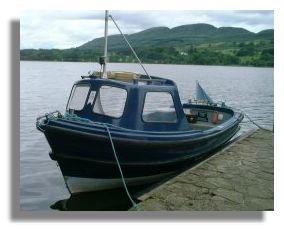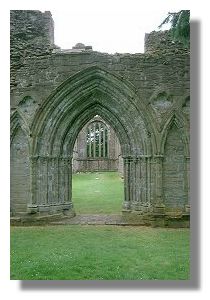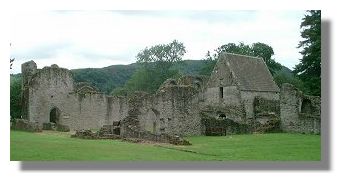
Location
 Inchmahome Priory is on an island on the Lake of Menteith, off the A873, 15 miles west of Stirling and five miles east of Aberfoyle, a popular town in the Trossachs area. The ruins are now under the care of Historic Scotland who run a small motor launch from the Port of Menteith out to the island. In springtime the island becomes colourful as a result of the daffodils and rhododendrons growing there.
Inchmahome Priory is on an island on the Lake of Menteith, off the A873, 15 miles west of Stirling and five miles east of Aberfoyle, a popular town in the Trossachs area. The ruins are now under the care of Historic Scotland who run a small motor launch from the Port of Menteith out to the island. In springtime the island becomes colourful as a result of the daffodils and rhododendrons growing there.
The Lake of Menteith is Scotland's only natural lake (there is a man-made Pressmennan Lake, in East Lothian - all the rest are lochs). Nobody knows for sure why Lake of Menteith is so called but the best guess is that some cartographer (English, probably) mistook "laigh" meaning low ground, for "lake" and the name stuck.
Early History
 The priory was founded in 1238 by Walter Comyn, earl of Menteith, for a group of Augustinians, although there appears to have been a church on the island prior to this. At that time, the Comyns were one of the most powerful families in Scotland and Walter had an imposing country house on Inchtalla, one of the other islands on the lake.
The priory was founded in 1238 by Walter Comyn, earl of Menteith, for a group of Augustinians, although there appears to have been a church on the island prior to this. At that time, the Comyns were one of the most powerful families in Scotland and Walter had an imposing country house on Inchtalla, one of the other islands on the lake.
King Robert the Bruce visited the priory in 1305, 1308 and 1310 and signed documents on these occasions and in 1358 the future King Robert II also stayed there.
The decline of monastic orders in the 16th century was hastened by the fact that the heads of abbeys and priories became appointees of the local landowner, who did not have the same religious fervour as the ordained priests. In 1547, the office passed to John, Lord Erskine who later became head of Cambuskenneth and Dryburgh Abbeys. Lord Erskine was a guardian of Mary Queen of Scots (she was aged four at this time) and in 1547 Mary was sent to Inchmahome, when the Earl of Hereford invaded Scotland on behalf of Henry VIII, in an attempt to force the Scots to agree to the marriage of Mary to Henry's son, Edward. This was known at the time as the "Rough Wooing". Mary and her mother, the dowager Queen, Mary of Guise, stayed on the island for three weeks (she went to France in 1548 and later married the Dauphin, the heir to the French throne).
By 1560 the priory was home to about 11 canons but the Reformation meant that there were no new priests and by 1606 the property passed to the Erskine family. It later passed to the marquis of Montrose and the 6th duke of Montrose passed it to the care of the State in 1926.
The Building
 Although the priory is now a ruin, enough remains to give a good impression of what the main parts of the building would have been like. The choir of the priory, which contained the high altar, is shown in the illustration at the top of this page. This was lit by the magnificent east window, with five lancets. This was the most sacred part of the building. During services, the celebrant and his assistants sat on the sedilia or seating arches (seen here).
Although the priory is now a ruin, enough remains to give a good impression of what the main parts of the building would have been like. The choir of the priory, which contained the high altar, is shown in the illustration at the top of this page. This was lit by the magnificent east window, with five lancets. This was the most sacred part of the building. During services, the celebrant and his assistants sat on the sedilia or seating arches (seen here).
Within the choir are a number of graveslabs and commemorative wall-plaques, many dedicated to the Graham family. One marks the grave of R B Cunnighame Graham who was co-founder of the Scottish Labour Party in the 1880s and the first President of the Scottish National Party (in 1928).

 The cloisters (shown above) were the main domestic buildings of the priory and these included a dormitory and a chapter house (which has recently been re-roofed) where the community met on a daily basis.
The cloisters (shown above) were the main domestic buildings of the priory and these included a dormitory and a chapter house (which has recently been re-roofed) where the community met on a daily basis.
Within the chapter house, Historic Scotland have placed a number of effigies and gravestones found on the island, so that they can be protected from the ravages of the weather. One of the best of these (though fairly worn) is an effigy of Walter, first earl of the Stewart line who died about 1295, along with his countess, Mary. It was his descendant, also named Walter, the 6th High Steward of Scotland, who married Marjorie Bruce, the daughter of Robert the Bruce. Their son succeeded to the throne on the death of King David II as King Robert II.



